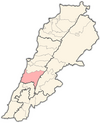Ammatour
Ammatour | |
|---|---|
Town | |
| Country | |
| Governorate | Mount Lebanon |
| District | Chouf |
| Highest elevation | 1,050 m (3,440 ft) |
| Lowest elevation | 800 m (2,600 ft) |
| Time zone | +2 |
| • Summer (DST) | +3 |
Ammatour (عمّاطور) is a town in the Shouf (Al-Shouf) District in Mount Lebanon Governorate of Lebanon. It lies 57 km southeast of Beirut, at an elevation of between 800 and 1,050 meters above sea level. The name "Ammatour" is derived from the words 'Ain Maa Tour', meaning the spring of the mountain. In fact, it is Lebanon's richest village in water sources, as its territory contains more than 365 springs, fountains, and a river.[1]
The village, or rather little town, is inhabited by around 5,000 registered residents made up of a Druze majority and a Christian minority consisting of Greek Melkite Catholics and Maronites, all living together in harmony for centuries. The largest and best known Druze families in Ammatour are Abou Chakra (also written Abu/Bou Shakra/Chakra) and Abdel Samad (also written Abdul/Abdel Samad), both of which have played major political, economical and religious roles in Lebanon's history, especially during the 19th century. The largest Christian families are Salem, Jebara (Gebara), Lutaif and Bu Raad.[2]
Ammatour enjoys one of the highest literacy and university education rates in Lebanon; its sons and daughters occupy prominent political, educational, cultural, financial and military positions both in Lebanon and abroad. Its state school, founded in 1929, is one of the oldest state schools in Lebanon, and the second to have its students sit for the intermediate certificate examinations. In 1936 a group of young educated Ammatouris founded one of Lebanon's first public libraries, and named it "Ghurfat Al-Mutala'a Ad-Dimuqratiyya" (The Democratic Reading Room). Within a few years, in 1943, they published their own magazine "Beit Ath-Thaqaafa" (The Culture Home), which was one of the first of its kind in the country.[3][4]
Politically and administratively, Ammatour was in 1711 declared one of the five "Special status" villages in Mount Lebanon, which were outside the control of any "Iqta'" - i.e., feudal lordship -, but rather paid their land tax directly to the treasury of the Governor's office. (4)[5][6][7] Furthermore, it has occupied a significant religious position as the birthplace of five Sheikh Aqls (Grand Muftis), i.e. religious leaders of the Druze community,[8][9] in addition to the fact that the first Patriarch of the Melkite Greek Catholic Church in the Middle East was anointed and appointed in Ammatour in 1724.,[a][10][11] and recently, one of its sons Bishop Joseph Gebara, was appointed Melkite Catholic Bishop of São Paulo, Brazil.[12]
Ammatour's first Municipal Council was created as early as 1927, and documented records show that it had Mayors as early as 1870.[3] The village's cultural activities are undertaken by its social and sporting clubs and associations, including: The Social Sporting Club of Ammatour - Amigos Ammatour sports association, The Ammatour Women's Association, and The Cultural Meeting Association (Jami'yyat Al-Liqaa Al-Thaqafi). The Amigos are one of the best sport clubs in the region, and has had a great era during the 1970s and 1980s, winning a lot of trophies in several sports, including: volleyball, basketball, swimming, chess, table tennis.[3][13][14]
In mid-September Ammatour celebrates its annual festival Eid Az-Zaitoun (The Olives Festival), which usually has rich musical and singing programmes marking the end of summer and welcoming the approaching olive season. Furthermore, Ammatour is now home to one of the world’s largest tree nurseries. It’s only half-finished at the moment, but when it is complete it will be a place where a million trees can be grown at a time and then transported to areas at risk of desertification and other threats to the environment.[15]
Notes
- ^ See the letter sent by HE Sheikh Mohammad Abu Shakra, The Sheikh Al-Aql of the Druze to Pope John Paul II in January 1983, published in the following:.
References
- ^ Merhij, Afif Butrus (1966). I’irif Lubnan. Qartaba. pp. 483–486.
{{cite book}}: CS1 maint: location missing publisher (link) - ^ Polk, William R. (1963). The Opening of South Lebanon, 1788-1840. Cambridge, Mass: Harvard University Press. pp. 59, 181–182.
- ^ a b c Abu Shakra, Nayel (February 2002). "عماطور: تاريخ وتراث". As-Saha (2): 21–32.
- ^ Abdul-Samad, Adel (ed.) (2006). Shu’araa min Ammatour (Poets from Ammatour). Ammatour: Adel Abdul-Samad. p. 6.
{{cite book}}:|author=has generic name (help) - ^ Polk, 1963 p.43
- ^ Al-Khoury, Shaker (1985). Majmaa’ Al-Massarrat (The Compendium of Joys) (2 ed.). Beirut: Dar Lahad Khater. p. 498.
- ^ Al-Basha, Mohammad Khalil (1990). Mu’jam A’alaam Ad-Duruz (Biography of Prominent Druze). Al-Mukhtara: Ad-Dar At-Taqaddumiyya. pp. 29–30.
- ^ Al-Basha, 1985 pp.29–44
- ^ Al-Basha, 1985 pp.138–150
- ^ as-Sughayyar, Sa’eed (1984). Banu Maa’rouf Fi at-Tareekh (Banu Maa’rouf – ie The Druze in history). Al-Qurayya: Zeineddin Publishers. p. 321.
- ^ Abbas Abu Saleh & Sami Makarem (1981). Tareekh Al-Muwahhideen Ad-Duruz As-Siyassi fi Al-Masreq Al-Arabi (The Political History of the Muwahhideen Al-Druze in the Arab East). Beirut: Al-Majlis Ad-Durzi Lil-Buhouth wa Al Inmaa.
- ^ "Article". L’Orient-Le Jour. Lebanon. 20 December 2013.
- ^ lkdg.org staff. "جمعية باسم "جمعية اللقاء الثقافي - عماطور"". مجموعة الأبحاث والتدريب للعمل التنموي. Retrieved 9 July 2015.
- ^ Al-Mustaqbal newspaper, Issue 4106, September 6, 2011
- ^ DIAGEO staff (2011). "A million trees – every year". Sustainability & Responsibility report 2011. DIAGEO. Retrieved 9 July 2015.

